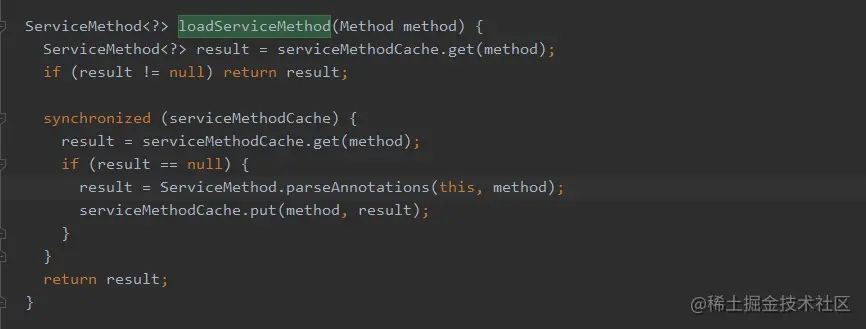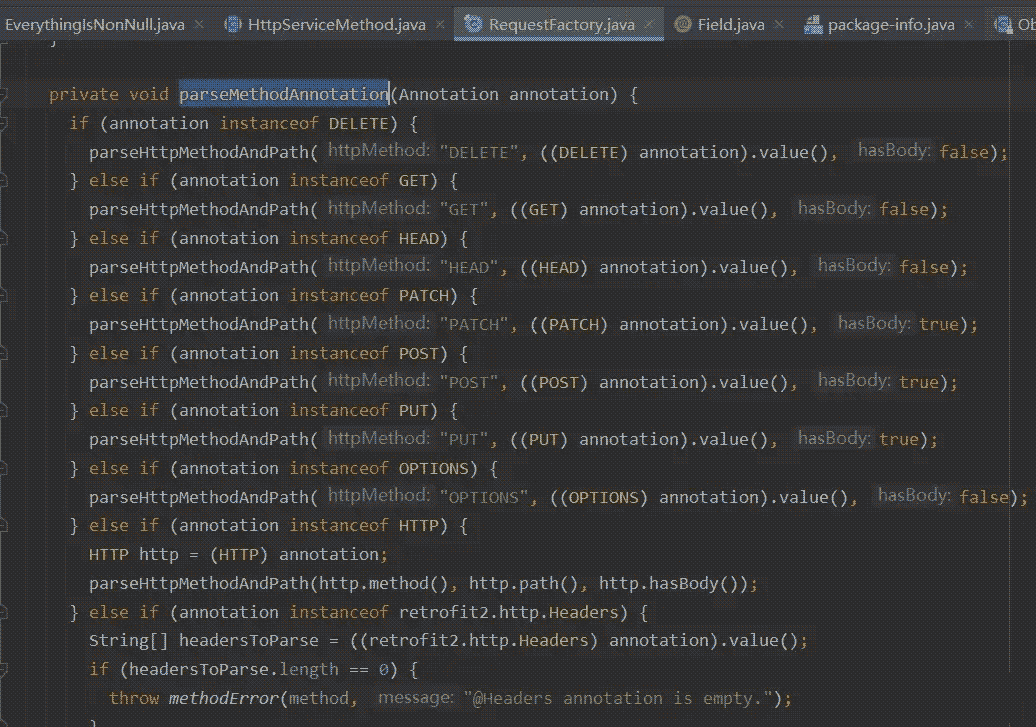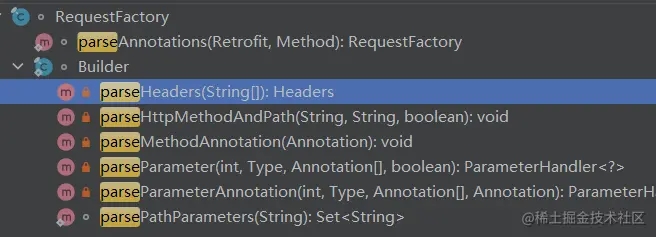Android開發Retrofit源碼分析
項目結構
把源碼 clone 下來 , 可以看到 retrofit 整體結構如下

圖 http包目錄下就是一些http協議常用接口 , 比如 請求方法 url , 請求體, 請求行 之類的
retrofit 使用
把retrofit使用作為分析的切入口吧 , retrofit單元測試使用如下
public final class BasicCallTest {
@Rule public final MockWebServer server = new MockWebServer();
interface Service {
@GET("/") Call<ResponseBody> getBody();
}
@Test public void responseBody() throws IOException {
Retrofit retrofit = new Retrofit.Builder()
.baseUrl(server.url("/"))
.build();
Service example = retrofit.create(Service.class);
server.enqueue(new MockResponse().setBody("1234"));
Response<ResponseBody> response = example.getBody().execute();
assertEquals("1234", response.body().string());
}
}
Retrofit 構建 , 以構建者模式構建出Retrofit

可以看到builer可以配置baseUrl , 回調線程池 , 還有一些適配器的工廠 , 這些適配器的作用後面說
Retrofit #create
從create 方法開始分析 , 跟進看下create 方法
public <T> T create(final Class<T> service) {
validateServiceInterface(service);
return (T)
Proxy.newProxyInstance(
service.getClassLoader(),
new Class<?>[] {service},
new InvocationHandler() {
private final Object[] emptyArgs = new Object[0];
@Override
public @Nullable Object invoke(Object proxy, Method method, @Nullable Object[] args)
throws Throwable {
// If the method is a method from Object then defer to normal invocation.
if (method.getDeclaringClass() == Object.class) {
return method.invoke(this, args);
}
args = args != null ? args : emptyArgs;
Platform platform = Platform.get();
return platform.isDefaultMethod(method)
? platform.invokeDefaultMethod(method, service, proxy, args)
: loadServiceMethod(method).invoke(args);
}
});
}
service 是請求的接口的class , 動態代理隻能是接口 , 所以validateServiceInterface 先驗證是不是接口 , 不是接口則拋異常。
method.getDeclaringClass() 獲取聲明類的Class。
比如 A類 有個method , method.getDeclaringClass() 返回為A.class , 如果method聲明類是Object.class 則直接method.invoke , 往下執行毫無意義。
Platform#get()會根據當前平臺獲取Platform 。

有點類似狀態模式思想 , 根據當前的平臺選擇合適的子類
public boolean isDefaultMethod(Method method) {
return method.isDefault();
}
isDefault , 在接口類型中以default關鍵字聲明 則返回true, 比如
interface InterfaceWithDefault {
void firstMethod();
default void newMethod() {
System.out.println("newMethod");
}
}
所以此處會返回 false 接著調用 loadServiceMethod。

ServiceMethod #parseAnnotations
跟進ServiceMethod #parseAnnotations
static <T> ServiceMethod<T> parseAnnotations(Retrofit retrofit, Method method) {
RequestFactory requestFactory = RequestFactory.parseAnnotations(retrofit, method);
return HttpServiceMethod.parseAnnotations(retrofit, method, requestFactory);
}
根據當前的方法信息構建出RequestFactory , 然後把具體實現細節交給HttpServiceMethod 處理 , HttpServiceMethod 繼承自ServiceMethod , 有三個子類 。

我們在Api.class定義的方法 , 解析並不是由HttpServiceMethod 完成 , 而是由RequestFactory去處理的 , 比如解析方法的註解。

更多的解析方法如下

方法解析的細節就不說瞭 , 繼續看RequestFactory 這個類 , 這個類的作用難道就是負責方法信息的解析 , 感覺和名字不太符合 , RequestFactory 顧名思義應該是用來構建Request的工廠 , 果不其然內部還有個 create 方法 , 用來構建okhttp3.Request的
//RequestFactory #create
okhttp3.Request create(Object[] args) throws IOException {
return requestBuilder.get().tag(Invocation.class, new Invocation(method, argumentList)).build();
}
就隻有這一個create方法 , 難道retrofit 就隻能使用okhttp來負責網絡請求 ? 答案是肯定的 , 從最開始的 loadServiceMethod(method).invoke(args)也可以看出 , 方法裡面隻構建出OkHttpCall 沒提供api可以讓我們切換到其他的網絡請求庫。

但是 , Call 又抽象成接口的形式 ,如下, 這麼做的目的可能是以後便於框架的維護

沿途風景再美麗 , 也要回到主線路 , 繼續分析 HttpServiceMethod#parseAnnotations
HttpServiceMethod#parseAnnotations
這個方法太長 , 貼關鍵代碼吧
static <ResponseT, ReturnT> HttpServiceMethod<ResponseT, ReturnT> parseAnnotations(
Retrofit retrofit, Method method, RequestFactory requestFactory) {
boolean isKotlinSuspendFunction = requestFactory.isKotlinSuspendFunction;
boolean continuationWantsResponse = false;
boolean continuationBodyNullable = false;
boolean continuationIsUnit = false;
Annotation[] annotations = method.getAnnotations();
Type adapterType;
if (isKotlinSuspendFunction) {
Type[] parameterTypes = method.getGenericParameterTypes();
Type responseType =
Utils.getParameterLowerBound(
0, (ParameterizedType) parameterTypes[parameterTypes.length - 1]);
if (getRawType(responseType) == Response.class && responseType instanceof ParameterizedType) {
continuationWantsResponse = true;
}
} else {
//非kt 協程情況
adapterType = method.getGenericReturnType();
}
CallAdapter<ResponseT, ReturnT> callAdapter =
createCallAdapter(retrofit, method, adapterType, annotations);
Type responseType = callAdapter.responseType();
Converter<ResponseBody, ResponseT> responseConverter =
createResponseConverter(retrofit, method, responseType);
okhttp3.Call.Factory callFactory = retrofit.callFactory;
if (!isKotlinSuspendFunction) {
//非kt 協程情況
return new CallAdapted<>(requestFactory, callFactory, responseConverter, callAdapter);
} else if (continuationWantsResponse) {
return (HttpServiceMethod<ResponseT, ReturnT>)
new SuspendForResponse<>(
requestFactory,
callFactory,
responseConverter,
(CallAdapter<ResponseT, Call<ResponseT>>) callAdapter);
} else {
return (HttpServiceMethod<ResponseT, ReturnT>)
new SuspendForBody<>(
requestFactory,
callFactory,
responseConverter,
(CallAdapter<ResponseT, Call<ResponseT>>) callAdapter,
continuationBodyNullable,
continuationIsUnit);
}
}
構建出HttpServiceMethod分兩種情況 :
- kotlin 協程情況
- 非Kotlin 協程情況
第二種 非Kotlin協程情況
第一種情況稍許復雜 , 先分析第二種
adapterType = method.getGenericReturnType();
@GET("/") Call<ResponseBody> getBody();
如果是上面代碼 , method.getGenericReturnType() = Call , 然後根據方法的返回值類型 / 方法註解信息 , 構建出CallAdapter 。
createCallAdapter() 方法會使用 CallAdapter.Factory 構建CallAdapter , 因為初始化retrofit的時候沒有配置CallAdapter.Factory , 所以會使用默認的DefaultCallAdapterFactory。
最終會進入DefaultCallAdapterFactory#get 。
DefaultCallAdapterFactory#get
這個方法作用就是返回CallAdapter , 修改下源碼加入兩個打印。
public @Nullable CallAdapter<?, ?> get(
Type returnType, Annotation[] annotations, Retrofit retrofit) {
final Type responseType = Utils.getParameterUpperBound(0, (ParameterizedType) returnType);
System.out.println("TAG" + " ->" + "returnType = " +getRawType(returnType) .getSimpleName());
System.out.println("TAG" + " ->" + "responseType = " +getRawType(responseType) .getSimpleName());
return new CallAdapter<Object, Call<?>>() {
@Override
public Type responseType() {
return responseType;
}
@Override
public Call<Object> adapt(Call<Object> call) {
return executor == null ? call : new ExecutorCallbackCall<>(executor, call);
}
};
}
運行可以看到以下打印信息

returnType = Call ,responseType =ResponseBody 。
總結一下 , returnType就是方法返回值 , responseType 就是方法返回值上的泛型 DefaultCallAdapterFactory會根據平臺環境去構建。

以Android24分析 , DefaultCallAdapterFactory(Executor callbackExecutor) , 構造方法中 , 線程池為主線程池 , 在retrofit初始化的時候添加到 到callAdapterFactories 集合中。
至此 , CallAdapterFactory 和 CallAdapter 分析完瞭 , 總結下就是給Call (retrofit內存隻有OkHttpCall 作為唯一實現類)做適配 , 讓其可以在 Rxjava / 協程 等各個環境中使用 Call。
非kt 協程情況下 , parseAnnotations 方法最終返回的是將requestFactory , callFactory , responseConverter, callAdapter 封裝好的CallAdapted 對象。
再次回到夢開始的地方Retrofit#create 方法 , loadServiceMethod獲取的ServiceMethod最終實現類為CallAdapted , 獲取之後會調用invoke方法 , invoke是一個final方法 , 裡面構建瞭OkHttpCall , 然後調用瞭adapt方法 , adapt中調用瞭callAdapter.adapt(call)。
@Override
protected ReturnT adapt(Call<ResponseT> call, Object[] args) {
return callAdapter.adapt(call);
}
這裡的ReturnT 就是ExecutorCallbackCall<>(executor, call) 對象 , 所以 example.getBody().execute() 就是調用ExecutorCallbackCall#execute方法
//ExecutorCallbackCall#execute
public Response<T> execute() throws IOException {
return delegate.execute();
}
delegate為OkHttpCall , 所以就調用到OkHttpCallCall#execute方法 , 這裡就轉給Okhttp去請求網絡加載數據瞭 , 代碼就不貼瞭 , 我們看下網絡請求之後 , 數據Response 的處理 , 關鍵代碼OkHttpCall#parseResponse。
Response<T> parseResponse(okhttp3.Response rawResponse) throws IOException {
ResponseBody rawBody = rawResponse.body();
ExceptionCatchingResponseBody catchingBody = new ExceptionCatchingResponseBody(rawBody);
try {
T body = responseConverter.convert(catchingBody);
return Response.success(body, rawResponse);
}
}
responseConverter 在 HttpServiceMethod#parseAnnotations 方法中獲取 , 回應數據轉換器 , 把數據轉換成我們可以直接使用的對象 , 比如我們常用的 GsonConverterFactory。
最後把轉換好之後的數據 , 封裝成Response對象返回。

response.body()就是responseConverter 轉換後的數據 來張大致流程圖感受下吧

第一種 Kotlin協程情況
其實大致流程第二種情況分析的差不多瞭 , 接下來分析下Retrofit對於kotlin的特殊處理吧。
if (Utils.getRawType(parameterType) == Continuation.class) {
isKotlinSuspendFunction = true;
return null;
}
協程掛起方法 , 第一個參數為Continuation , 所以判斷是不是掛起方法也很簡單 , 根據ResponseType 去構建協程專用的HttpServiceMethod , 主要有兩類。
- SuspendForResponse , 對應type為Continuation<Response>
- SuspendForBody , 對應type為Continuation
這裡看下 SuspendForBody 實現 , 套娃情況就不分析瞭。

如果是這樣使用 , 最終會調到SuspendForBody #adapt。
@Override
protected Object adapt(Call<ResponseT> call, Object[] args) {
call = callAdapter.adapt(call);
Continuation<ResponseT> continuation = (Continuation<ResponseT>) args[args.length - 1];
try {
//去掉幹擾代碼 , 僅保留這個
return KotlinExtensions.awaitNullable(call, continuation);
}
}
這個地方就很關鍵瞭 , java 直接調kotlin 協程 suspend 方法。
KotlinExtensions.awaitNullable 會調到KotlinExtensions#await方法。
retrofit與協程適配的細節都在 KotlinExtensions這個類裡。
進入await , 可以看到使用suspendCancellableCoroutine把回調裝換成協程。
@JvmName("awaitNullable")
suspend fun <T : Any> Call<T?>.await(): T? {
return suspendCancellableCoroutine { continuation ->
continuation.invokeOnCancellation {
cancel()
}
enqueue(object : Callback<T?> {
override fun onResponse(call: Call<T?>, response: Response<T?>) {
if (response.isSuccessful) {
continuation.resume(response.body())
} else {
continuation.resumeWithException(HttpException(response))
}
}
override fun onFailure(call: Call<T?>, t: Throwable) {
continuation.resumeWithException(t)
}
})
}
}
其實內部也是調用 OkHttp Call.enqueue() , 隻不過是用suspendCancellableCoroutine給協程做瞭一層包裝處理
通過 suspendCancellableCoroutine包裝之後使用就很簡單瞭。
GlobalScope.launch {
try {
val result = xxxApi.getXxx()
} catch (exception: Exception) {
}
}
總結
Call 這個接口用於與網絡請求庫做適配 , 比如Okhttp。
CallAdapter 用於retrofit 與各種環境搭配使用做適配 , 比如rxjava / 協程 / java。
Converter 用於將請求結果轉換實體類Bean 或者其他。
用到的設計模式有: 動態代理/靜態代理 / 構建者 / 工廠 / 適配器 / 狀態 等。
以上就是Android開發Retrofit源碼分析的詳細內容,更多關於Android Retrofit源碼分析的資料請關註WalkonNet其它相關文章!
推薦閱讀:
- 詳解如何魔改Retrofit實例
- android Retrofit2網絡請求封裝介紹
- java實用型-高並發下RestTemplate的正確使用說明
- 關於RestTemplate的使用深度解析
- Android使用 Coroutine + Retrofit打造簡單的HTTP請求庫